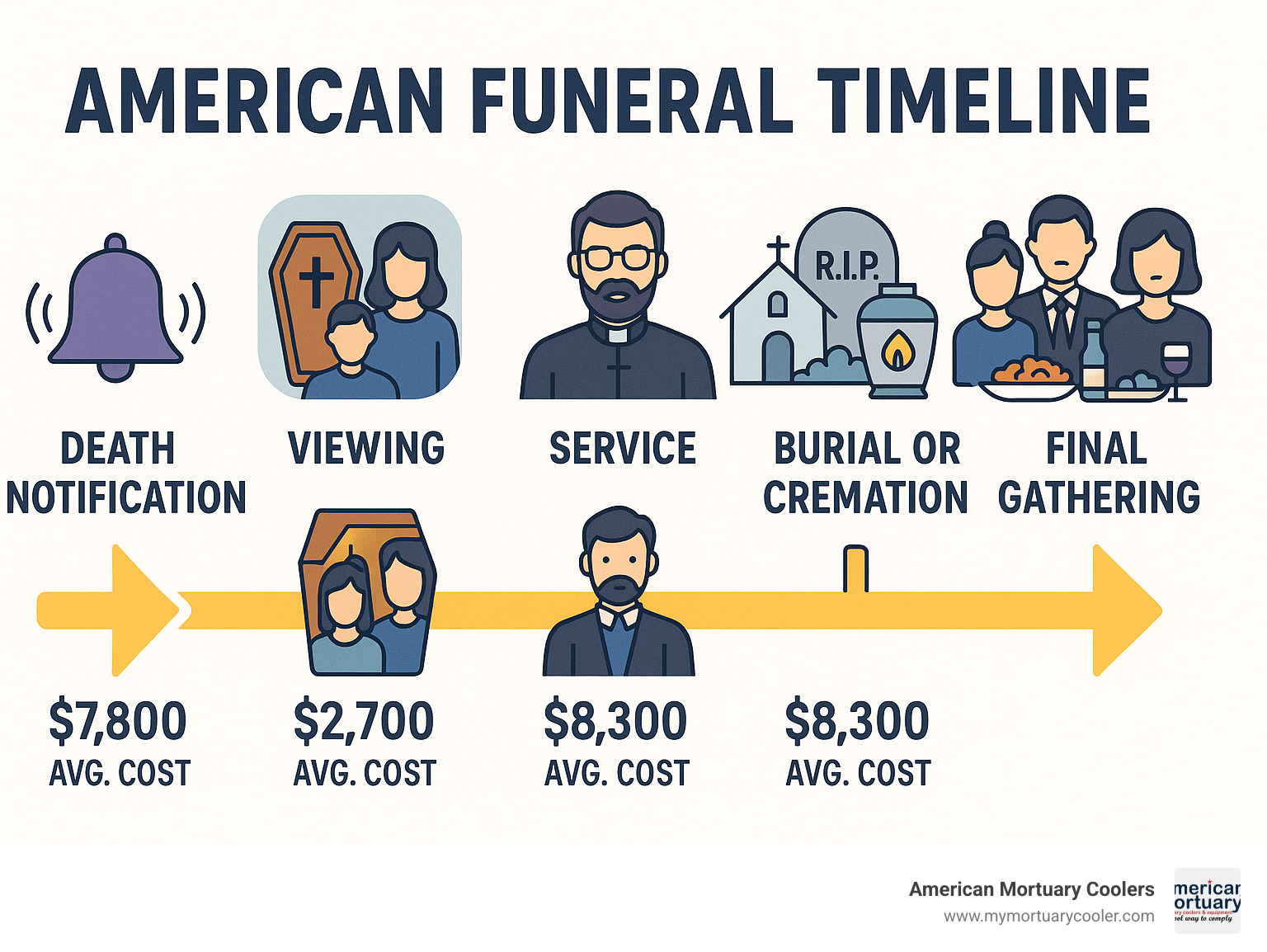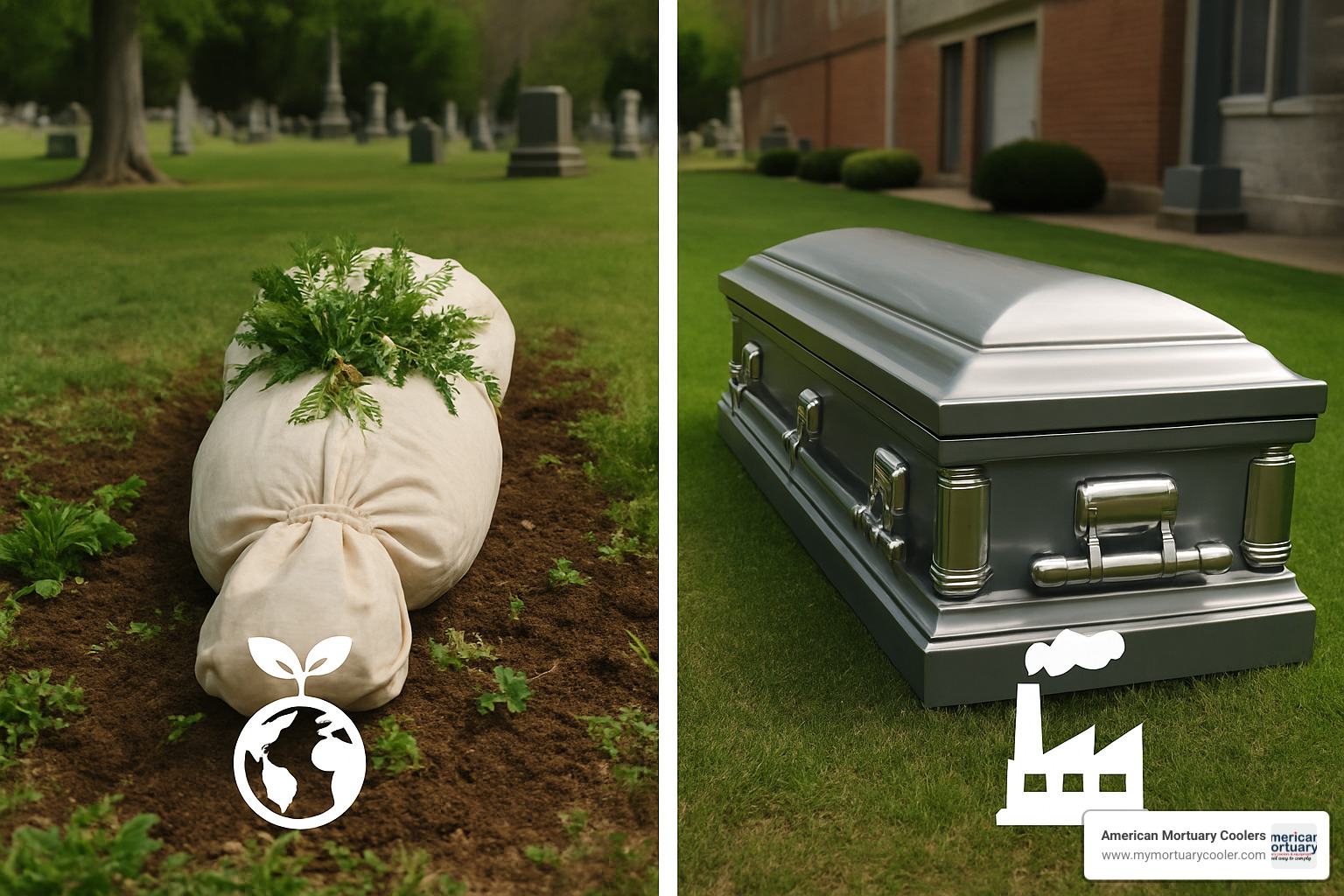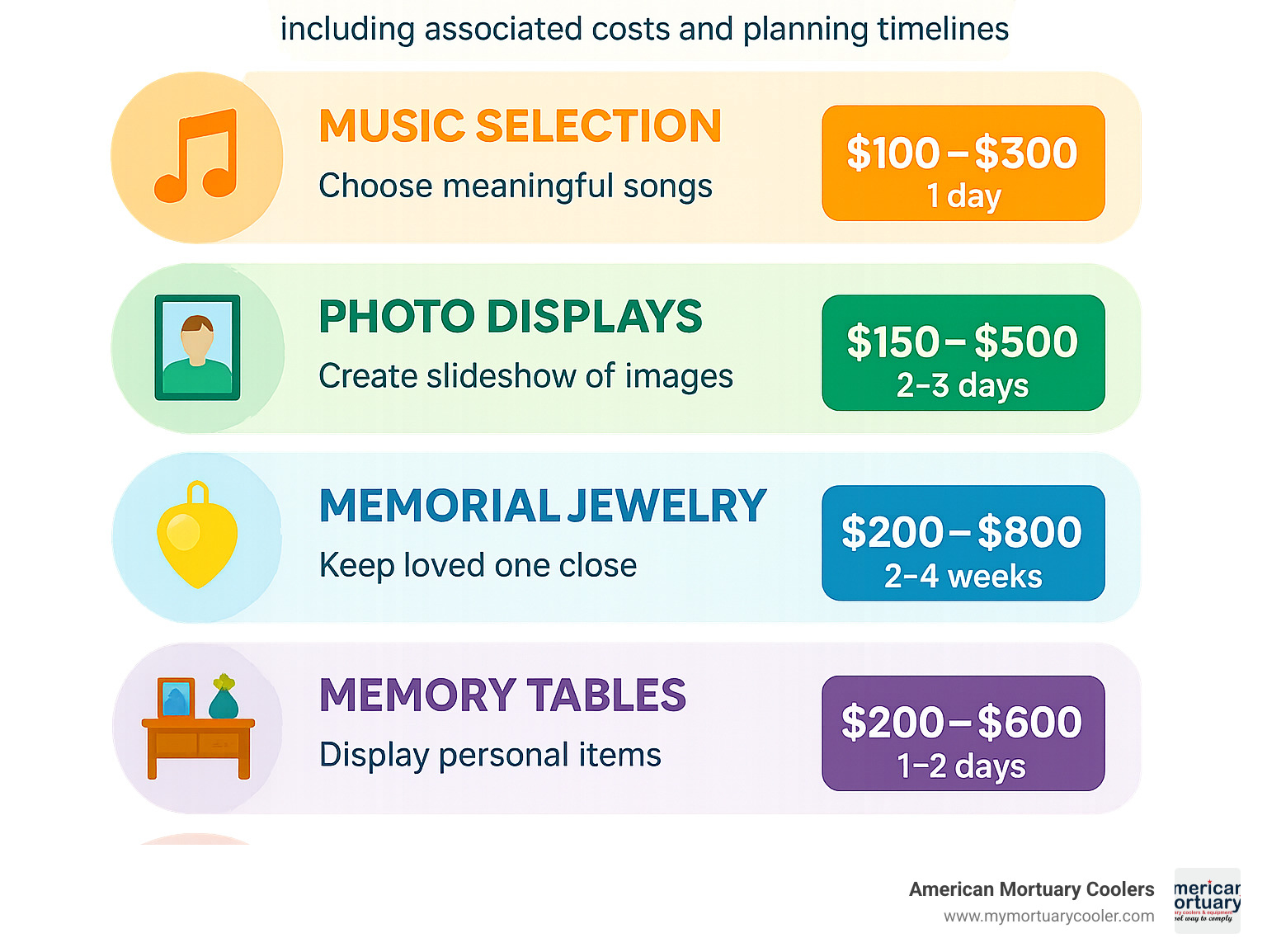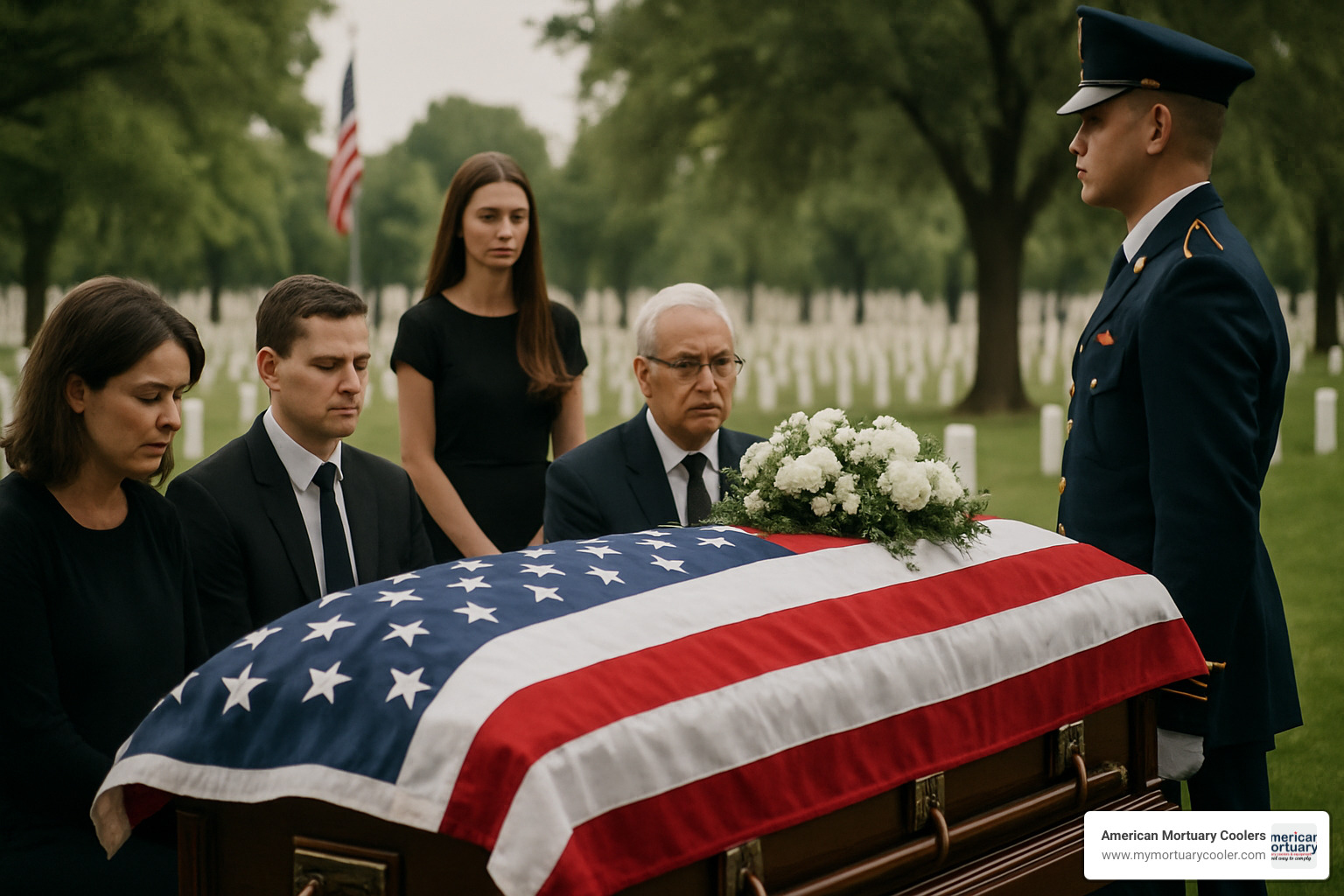Understanding American Funeral Traditions and Practices
American-funeral customs represent a unique blend of historical traditions, cultural diversity, and modern innovations that help families honor their loved ones and steer the grieving process. These ceremonies have evolved from simple colonial home gatherings to today's personalized celebrations of life.
Key Elements of American Funerals:
- Viewing/Visitation - Family and friends gather to pay respects, typically 1-3 days before the service
- Funeral Service - Religious or secular ceremony with eulogies, readings, and music
- Burial or Cremation - Final disposition, with cremation now chosen by 61.9% of Americans
- Reception/Gathering - Post-service meal where mourners share memories
- Average Cost - Traditional burial ranges $5,685-$12,430, cremation $495-$10,105
- Timeline - Process typically spans 3-7 days from death to final service
The modern American funeral industry serves over 2.8 million deaths annually. Today's families increasingly seek personalized ceremonies that reflect the deceased's personality and values rather than following rigid traditional formats.
Current trends show Americans moving toward more affordable options like direct cremation, eco-friendly green burials, and celebration-of-life gatherings. The overall shift emphasizes meaningful personalization over expensive displays.
We're American Mortuary Coolers, a Tennessee-based supplier helping funeral homes across America maintain proper body preservation standards for American-funeral services. Our mortuary equipment experience has given us insights into how funeral homes serve grieving families during their most difficult times.

Essential American-funeral terms:
From Colonial Parlors to Modern Chapels: A Brief History
The story of American-funeral practices begins in colonial homes, where families gathered to wash and dress their loved ones. Death was a family affair - the deceased would be laid out in the family parlor (where "funeral parlor" originates), and neighbors would bring food while offering comfort.
These early colonial wakes were simple events reflecting Puritan values of community support. Women in the community created an informal network of death care passed down through generations.
The Victorian era brought dramatic changes. Grief became elaborate and highly ritualized, with families wearing mourning jewelry, observing strict mourning periods, and following detailed rules about clothing and social activities. The Victorians turned mourning into an art form with symbolic flowers, elaborate headstones, and mourning photography.
Then came the Civil War - and everything changed. The war created an unprecedented challenge: transporting soldiers' bodies home. The answer was embalming, a preservation technique never used on such a massive scale.
Abraham Lincoln's death in 1865 became the ultimate demonstration of embalming's potential. His preserved body traveled by train across the country, allowing millions to pay respects. The Smithsonian notes that Lincoln's funeral tour served as public education about embalming, showing families that preservation was both dignified and practical.
This period marked the rise of professional undertakers who became today's funeral directors. Mortuary science programs emerged in the late 1800s, establishing the educational foundation that professionalized the industry.
Key Turning Points in American-funeral Evolution
The shift from home funerals to funeral homes represents the most significant change in American death customs. Funeral homes offered specialized facilities with proper lighting, adequate seating, and equipment for professional body preparation.
Embalming adoption accelerated after the Civil War. This enabled extended viewing periods and long-distance transport, allowing families to hold services in their home communities even if death occurred elsewhere.
Funeral director licensing brought consistency and quality assurance to an industry that had operated with minimal regulation.
How Wars & Technology Shaped the Industry
The Civil War's impact created the entire infrastructure for modern death care. Transportation networks, preservation techniques, and professional standards all emerged from wartime necessity.
Lincoln's funeral tour fundamentally changed how Americans thought about death care. Refrigeration technology brought another revolution - modern mortuary coolers like our custom units provide alternatives to immediate embalming while maintaining proper preservation.
The digital age brought online guestbooks and livestreaming technology, enabling distant family participation. Today's American-funeral industry reflects this evolution from home-based community care to professional funeral services, emphasizing meaningful personalization over expensive displays.
The Modern American-funeral: Step-by-Step Overview
When a family faces loss, the American-funeral process typically unfolds over several days with carefully orchestrated steps designed to honor the deceased while providing comfort to those left behind.
The journey usually begins with a viewing or visitation, where family and friends gather to pay respects. This allows people to say goodbye, whether with an open casket or closed casket surrounded by flower tributes and photographs. Many families find this gathering helps make the loss feel real while providing early opportunities for support.
The funeral service combines eulogies from family and friends with readings and hymns that reflect the deceased's beliefs and personality. Modern services often blend traditional elements with personal touches - perhaps playing favorite music or inviting spontaneous memory sharing.
Following the service, a funeral procession accompanies the deceased to their final resting place. For veterans, military honors add dignity with flag presentations. Pallbearers carry the casket as a final act of service.
The day often concludes with a reception where mourners gather for shared meals and storytelling, demonstrating how communities support grieving families.
Sequence of an American-funeral
The typical timeline spans three to seven days, beginning when the funeral home takes custody. Families usually schedule viewing one to three days before the main service, allowing travel time and multiple opportunities for respects.
Guest books create lasting records while giving visitors a place to write support messages. Service duration varies - simple ceremonies might last 30 minutes while elaborate celebrations of life can extend over two hours.
More info about x services can help families understand their options.
Roles of Funeral Homes & Directors
Funeral directors handle everything from initial arrangements and embalming to coordinating with clergy and managing paperwork. They help families steer choices about caskets, urns, service locations, and timing while respecting budget constraints.
Modern funeral homes serve as support centers where families make decisions at their own pace. Quality mortuary coolers are essential infrastructure enabling funeral homes to maintain dignified standards while giving families adequate planning time.
Grief support extends beyond the funeral day, with many directors providing counseling referrals and organizing support groups.
A Comprehensive Guide to Funeral Director Equipment explores the professional tools enabling dignified care.
Burial vs. Cremation in the U.S.: Costs, Customs & Trends
When families choose between burial and cremation for their American-funeral, they're joining millions navigating this personal decision. Cremation is now chosen by 61.9% of Americans, while traditional burial accounts for 33.2% - a complete reversal from just a generation ago.
Traditional burial involves major expenses: casket (ranging from under $1,000 to over $10,000), burial vault, cemetery plot, and maintenance fees. In Washington state, full-service burials average $7,659, ranging from $5,685 to $12,430.
Cremation offers more flexibility. Direct cremation averages $1,535 nationally, ranging from $495 to $4,450 in Washington. Full-service cremation combines traditional elements with cremation, averaging $5,306 and ranging from $3,035 to $10,105.

Environmental impact increasingly influences decisions. Traditional burial requires significant land and often involves embalming chemicals. Cremation produces emissions but needs less land. Green burial options use biodegradable materials and avoid chemical preservation.
Cost Breakdown & Funding Options
Basic service fees form the foundation regardless of burial or cremation choice, covering funeral director services and facility use. Merchandise costs vary wildly based on selections.
Insurance assignments provide immediate relief through companies like American Funeral Financial, processing life insurance within 24 hours. Pre-need plans let people plan at today's prices while documenting wishes.
Proper refrigeration equipment helps families take time with decisions. Our cooling solutions give funeral homes flexibility to preserve remains safely while families make arrangements. More info about funeral supplies
Emerging Preferences & Innovations
Aquamation offers an environmentally friendly alternative using water-based processes. Memorial art services create keepsakes incorporating cremated remains. Digital legacy services preserve online presence, while livestreaming allows virtual participation.
Eco-friendly options continue growing, from mushroom suits to memorial reefs. These innovations reflect Americans' desire for personalized, meaningful farewells that honor individual lives while emphasizing choice, personalization, and environmental responsibility.
Personalization, Culture & New Directions
Modern American-funeral services increasingly reflect America's diverse cultural landscape. Religious rites vary from traditional Christian services to Jewish funerals without viewings, to Hindu cremation ceremonies following specific protocols.
Regional differences persist - Southern traditions emphasize extended family gatherings, while Western states favor casual celebration-of-life formats. Native American communities may incorporate smudging rituals, while Hispanic families organize vibrant celebrations emphasizing joyful remembrance.
Funeral etiquette continues evolving, with dress codes relaxing in many contexts. While dark clothing remains standard, some families request bright colors reflecting the deceased's personality. Children's attendance has become more accepted as families recognize the educational value of including young people in mourning rituals.
Designing a Meaningful American-funeral
Personalization has become the hallmark of contemporary funerals. Families create custom music playlists, photo slideshows combining life images, and keepsake jewelry incorporating personal elements.
Memorial trees offer living tributes benefiting the environment. Display tables featuring personal items help attendees remember the deceased's interests and create conversation starters encouraging memory sharing.

Alternative & Green Memorials
Natural burial practices eliminate embalming chemicals and use biodegradable materials. Green cemeteries resemble natural landscapes rather than manicured grounds.
Mushroom suits and innovative burial shrouds accelerate decomposition while enriching soil. Sea scatterings provide meaningful options for those connected to water. Memorial reefs combine cremated remains with environmentally safe concrete supporting marine life. More info about cremation urn choices
Pre-Planning, Insurance & Support for Families
Planning ahead for your American-funeral spares loved ones from difficult decisions while grieving and ensures your service reflects personal values. Funeral insurance offers straightforward coverage through policies designed for final expenses, typically welcoming seniors regardless of health conditions.
Families can set up trusts or payable-on-death accounts providing immediate funeral fund access without probate delays. Grief support extends beyond the service through professional grief counseling, support groups, and online communities helping process loss over months and years.

How to Pre-Plan an American-funeral
Creating advance directives goes beyond basic preferences. Consider music, readings, and overall tone - solemn traditional ceremony or celebration filled with stories. Choosing a funeral home ahead allows pressure-free shopping and comparison.
Pre-need contracts lock in today's prices for future services, offering real financial protection. Veteran benefits deserve attention as they significantly reduce costs while providing meaningful honors including burial allowances and military ceremonies.
The Definitive Guide to American Funeral Sites and Service Providers
Supporting the Bereaved Before & After Services
Meal trains ensure families receive home-cooked meals when cooking feels impossible. Sympathy cards with specific memories provide genuine solace and become treasured keepsakes.
Digital memorial pages revolutionize ongoing connections, allowing continued photo and story sharing. Anniversary remembrances acknowledge that grief continues beyond funeral receptions. Counseling referrals provide professional help when grief becomes overwhelming.
At American Mortuary Coolers, proper preparation and community support make difficult times manageable. Our custom equipment helps funeral homes provide professional care during families' most vulnerable moments.
Frequently Asked Questions about American-funeral Services
What should I wear to an American-funeral?
Modern American-funeral etiquette has evolved beyond the traditional "black clothing only" rule. Conservative business attire remains the safest choice - dress pants or skirt, button-down shirt, and closed-toe shoes. Dark colors like navy, gray, or black show respect.
Many families now include specific dress requests in obituaries. Some ask for bright colors reflecting their loved one's personality, casual attire for outdoor celebrations, or themed clothing honoring interests or military service. When in doubt, ask a family member or the funeral home directly.
How much does a typical funeral cost and why?
Traditional full-service burials average $7,659 in Washington state, while full-service cremations run about $5,306. Direct cremation offers the most budget-friendly option at approximately $1,535.
Basic service fees cover funeral director coordination and facility use, representing 20-30% of expenses. Merchandise costs create the biggest variable - caskets range from under $1,000 to over $10,000. Additional expenses include cemetery plots, transportation, and flowers.
Pre-planning remains the best way to control expenses, allowing thoughtful decisions without immediate pressure.
What is the difference between a funeral and a celebration of life?
Traditional funerals follow structured formats emphasizing mourning and formal ceremony, typically occurring within days of death. Celebrations of life emphasize joyful remembrance, focusing on celebrating the person's positive impact with a party-like atmosphere.
Timing flexibility differs significantly - celebrations can happen weeks or months later. Format differences are striking, with celebrations featuring informal memory sharing, favorite music, and social interaction rather than solemn protocols.
Many families now combine both approaches - traditional funeral for immediate family followed by larger celebration for the broader community. Neither option is inherently better; they serve different needs in honoring loved ones and processing grief.
Conclusion
American-funeral traditions have evolved from humble colonial beginnings while serving the same vital purpose: honoring those we've lost and supporting each other through grief. Today's families are reshaping customs to match their values, with growing preferences for cremation, eco-friendly green burials, and celebration-of-life services.
Technology is revolutionizing remembrance through virtual attendance, digital memorial pages, and innovative preservation methods. Yet our deep human need to gather, share stories, and support each other remains unchanged.
At American Mortuary Coolers, we've supported funeral professionals across America for years. Our custom mortuary equipment helps funeral homes maintain the highest care standards during families' most vulnerable moments. From our Tennessee workshop, we craft durable cooling solutions with direct delivery throughout the contiguous 48 states.
The future of American-funeral services will continue balancing respect for tradition with innovation. Families want ceremonies honoring their loved one's unique story while staying within budget, including distant relatives through technology while maintaining intimate, personal connections.
Whether choosing traditional burial, simple direct cremation with backyard celebration, or emerging green alternatives, the goal remains creating meaningful farewells that help everyone begin healing. The beauty of modern customs lies in their flexibility - there's no single "right" way to say goodbye.
Planning ahead makes all the difference. When people communicate preferences to families, it removes stress during overwhelming times. Quality funeral directors, reliable equipment, and strong community support ensure every American-funeral accomplishes its most important job: helping love live on. Supplying Serenity: A Guide to Funeral Supply Stores
